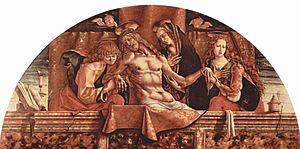卡罗.克里韦利Carlo Crivelli
卡罗.克里韦利Carlo Crivelli(1430年—1495年),意大利画家。
早期的生活
Crivelli出生在1430 - 35威尼斯一个画家,他的艺术形成的家庭中帕多瓦。Crivelli的职业仍然稀疏的细节:据说他学习下Jacobello百花大教堂绘画,直到1436年,当时Crivelli可能是唯一的一个男孩。他还在学校的学习Vivarini在威尼斯,然后离开威尼斯帕多瓦,他被认为是在车间工作弗朗西斯科·Squarcione然后,在1457年被判处有期徒刑6个月和一个已婚的女人,1459年离开扎达尔达尔马提亚(克罗地亚的一部分,但当时威尼斯的领土)。
职业生涯
圣托马斯·阿奎那,1476年
他是主人自己的商店在1457年因通奸被送进监狱。照片上的日期签署生存延长从1468年在一个教堂的祭坛的装饰品在马萨圣Silvestro Fermana近了费尔莫1493之间的死基督施洗圣约翰,圣母,在米兰的抹大拉的马利亚布雷拉美术馆.
尽管威尼斯艺术家宣传他的起源和他的签名,通常一些变异,卡洛斯Crivellus威尼托(“威尼斯卡洛Crivelli”),Crivelli似乎主要是在工作3月的安科纳,特别是在和附近阿斯科利Piceno。只有两张图片可以发现今天在威尼斯,在教会的圣塞巴斯蒂安。.
他画的蛋彩画,尽管越来越受欢迎油画在他有生之年,电池板,尽管他的一些作品转移画布。他偏爱装饰地穿孔镀金的背景是这个保守的品味的标志之一,在一定程度上由他的顾客。他的早期polyptychs,只有一个,装饰画从阿斯科利Piceno,幸存全部在原来的框架。所有的其他人已经拆卸和面板和祭坛的台场景分给几个博物馆。
同时代的无定形的乐队,模仿者和追随者,称为Crivelleschi,反映他的风格的不同程度方面。
工作
圣弗朗西斯与基督的血,c。1500
与自然的趋势出现在佛罗伦萨在他有生之年,Crivelli继续代表宫廷的风格国际哥特式感性。他的城市设置是贵重的,充满精致的寓言的细节。他赞成翠绿的景观背景,和他的作品可以被他的特点用水果和鲜花的装饰图案,经常被描绘在吊坠花彩,[4]也是一个标志Francesco Squarcione Paduan工作室的Crivelli可能工作的地方。
他的画有一个线性质量确认和他的翁布里亚语的同时代人。Crivelli画家的个性。不像乔凡尼贝里尼,他的当代,他的作品不是“软”,但在轮廓清晰和明确的对细节的关注。他使用“错视画”,经常与的作品中找到北方文艺复兴时期画家像Rogier van der Weyden,包括对象,例如珠宝和装甲建模在石膏面板。
委托开展的弗兰西斯科人和道明会阿斯科利,Crivelli专门宗教性质的工作。他的画作的力度还不够大麦当娜和孩子图片,圣母怜子图,圣坛雕刻称为polyptychs越来越不合时宜。经常充满痛苦的画面,比如裂开的伤口在基督的手,一边和哀悼者的嘴扭曲痛苦,Crivelli的工作满足顾客的精神需求。这些真实,有时令人不安的品质往往让人标签Crivelli的画作“怪诞”,就像他的意大利北部画家,西发信息给鲍思高堂另。他的作品吸引了众多著名的佣金和必须有吸引顾客的口味。
卡洛Crivelli马尔凯(可能死亡阿斯科利Piceno在1495年左右)。维托里奥Crivelli偶尔与他合作,他的弟弟。彼得罗各,一个画家从德国/奥地利移民到安科纳的3月,是他的瞳孔和合作者。Donato Crivelli,Jacobello的学生,是在1459年,可能是卡罗一样的家庭。
声誉
'圣母怜子图,1493年
他的工作他死后失宠瓦萨里的生活最优秀的画家、雕塑家和建筑师尤其是佛罗伦萨的前景,没有提到他。他的复兴,特别是在英国,期间的拉菲尔前派的画家,几个人,包括爱德华·伯恩-琼斯钦佩他的工作。名声褪色的运动,但最近的作品在他的工作和他的rehanging工作伦敦国家美术馆已经给他带来了新的关注。
苏珊·桑塔格在指出在“营”写道:“阵营卡洛Crivelli的画作,经常与他们真正的珠宝和昆虫和砌体裂缝”
Early life
Crivelli was born around 1430–35 in Venice to a family of painters and received his artistic formation there and in Padua. The details of Crivelli's career are still sparse:He is said to have studied under Jacobello del Fiore, who was painting as late as 1436; at that time Crivelli was probably only a boy. He also studied at the school of Vivarini in Venice, then left Venice for Padua, where he is believed to have worked in the workshop of Francesco Squarcione and then, after being sentenced in 1457 to a six-month prison term for an affair with a married woman, left in 1459 for Zadar in Dalmatia (now part of Croatia, but then a Venetian territory).
Career
He was master of his own shop when sent to prison for adultery in 1457. The dates he signed on the pictures that survive extend from 1468 on an altarpiece in the church of San Silvestro at Massa Fermana near Fermo to 1493 on The Dead Christ between St John, the Virgin and Mary Magdalene in Milan's Brera Gallery.
Though the artist advertised his Venetian origins with his signature, often some variation on Carolus Crivellus Venetos ("Carlo Crivelli of Venice"),Crivelli seems to have worked chiefly in the March of Ancona, and especially in and near Ascoli Piceno. Only two pictures can be found today in Venice, both in the church of San Sebastiano.
He painted in tempera only, despite the increasing popularity of oil painting during his lifetime, and on panels, though some of his paintings have been transferred to canvas. His predilection for decoratively punched gilded backgrounds is one of the marks of this conservative taste, in part imposed by his patrons. Of his earlypolyptychs, only one, the altarpiece from Ascoli Piceno, survives in its entirety in its original frame. All the others have been disassembled and their panels andpredella scenes are divided among several museums.
An amorphous band of contemporaries, imitators and followers, termed Crivelleschi, reflect to varying degrees aspects of his style.
Work
Unlike the naturalistic trends arising in Florence during his lifetime, Crivelli's style continues to represent the courtly International Gothic sensibility. His urban settings are jewel-like and full of elaborate allegorical detail. He favored verdant landscape backgrounds, and his works can be identified by his characteristic use of fruits and flowers as decorative motifs, often depicted in pendant festoons,[4] which are also a hallmark of the Paduan studio of Francesco Squarcione, where Crivelli may have worked.
His paintings have a linear quality identified with his Umbrian contemporaries. Crivelli is a painter of marked individuality. Unlike Giovanni Bellini, his contemporary, his works are not "soft", but clear and definite in contour with marked attention to detail. His use of "trompe l'oeil", often compared with that found in the works of Northern Renaissance painters like Rogier van der Weyden, includes raised objects, such as jewels and armor modeled in gesso on the panel.
Commissioned by the Franciscans and Dominicans of Ascoli, Crivelli's work is exclusively religious in nature. His paintings consist largely of Madonna and Childimages, Pietà, and the altarpieces known as polyptychs that were increasingly unfashionable. Often filled with images of suffering, such as gaping wounds in Christ's hands and side and the mouths of mourners twisted in agony, Crivelli's work fulfills the spiritual needs of his patrons. These ultra-realistic, sometimes disturbing qualities have often led critics to label Crivelli's paintings "grotesque",[citation needed] much like his fellow Northern Italian painter, Cosimo Tura. His work attracted numerous prestigious commissions and must have appealed to the taste of his patrons.
Carlo Crivelli died in the Marche (probably Ascoli Piceno) around 1495. Vittorio Crivelli, with whom he occasionally collaborated, was his younger brother. Pietro Alemanno, a painter who immigrated to the March of Ancona from Germany/Austria, was his pupil and collaborator. Donato Crivelli,[4] who was also a pupil of Jacobello and was working in 1459, may be of the same family as Carlo.
Reputation
His work fell out of favor following his death and Vasari's Lives of the Most Excellent Painters, Sculptors, and Architects, which is notably Florentine in its outlook, does not mention him. He had something of a revival, especially in the UK, during the time of the pre-Raphaelite painters, several of whom, including Edward Burne-Jones, admired his work. His reputation faded with that movement, but recent writings on his work and a rehanging of his work in the National Gallery, London, have brought him renewed attention.
Susan Sontag in Notes on "Camp" wrote: "Camp is the paintings of Carlo Crivelli, with their real jewels and trompe-l'oeil insects and cracks in the masonry".
艺术官网信息声明
1、本站美术网信息均来自于美术家自己或其朋友、网络等方式,本站无法确定每条信息或事件的真伪,仅做浏览者参考。
2、只要用户使用本站则意味着该用户以同意《本站注册及使用协议》,否则请勿使用本站任何服务。
3、信息删除不收任何费用,VIP会员修改信息终身免费(VIP会员点此了解)。
4、未经本站书面同意,请勿转载本站信息,谢谢配合!
- 卢齐欧·封塔纳
- 乔治·莫兰迪
- 约翰·威廉·戈德沃德
- 列奥纳多达芬奇
- 拉斐尔·桑西Raffaello Sanzio
- 巴拉 Giacomo Balla
- 皮耶罗德尔波莱欧罗 Piero del Pollaiolo
- 吉奥瓦尼安布罗乔德普莱德 Ambrogio de Predis
- 蓬托尔莫Pontormo
- 庞贝马萨尼 Pompeo Massani
- 詹巴蒂斯塔皮托尼Giambattista Pittoni
- 皮萨内洛Pisanello
- 平图里基奥Pinturicchio
- 皮诺·德埃尼Pino Daeni
- 萨诺迪皮特罗 Sano di Pietro
- 彼得罗·佩鲁吉诺Pietro Perugino
- 彼得隆吉Pietro Longhi
- 彼得罗·达·科尔托纳Pietro Da Cortona
- 皮埃特罗阿尼戈尼Pietro Annigoni
- 皮耶罗·迪·科西莫Piero di Cosimo
- 巴托洛梅.帕萨罗蒂Bartolomeo Passarotti
- 帕米贾尼诺Parmigianino
- 保罗·委罗内塞Paolo Veronese
- 保罗·乌切洛Paolo Uccello








